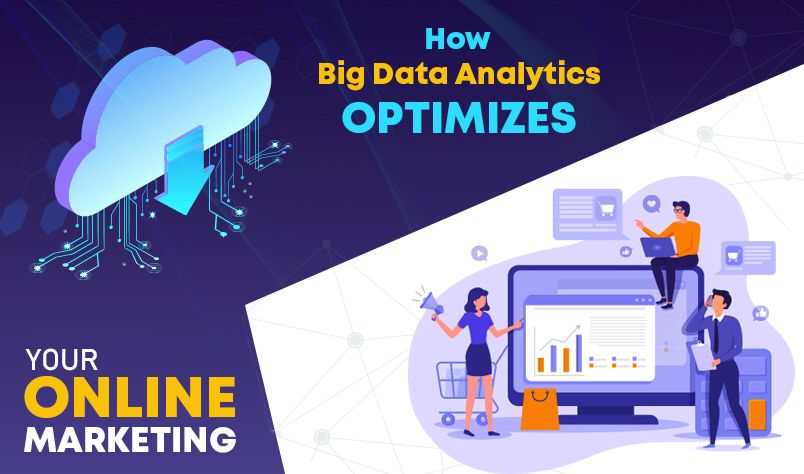-
Get Cloud GPU Server - Register Now!
Toggle navigation

Do you know how much data we generate on the internet every day?
According to the latest statistics, 2.5 quintillion bytes of data is created each day. Mind-boggling, isn’t it?
So where does all this data come from?
Every minute:
This colossal amount of data is a treasure trove for marketers. It can provide eye-opening insights on internet users: what are their interests, what kind of connections they have, what products or services they are looking for, how much time they spend online, which social media channels they are active on and so on.
Whether you own a start-up, head the marketing department in an enterprise or intend to grow your Youtube channel, your goal should be to milk the maximum benefit from this data. And this is where Big Data analytics comes into the picture.
There are many ways in which you can optimize your online marketing efforts using Big Data analytics:
Think of the days when marketing meant creating captivating ads for television, print media or billboards that targeted everyone under the sun. With changing times, this one-size-fits-all approach has become obsolete. Marketers have switched to a more customer-centric approach.
Today they try to connect with a specific target audience and win them over by catering to all their needs and interests.
Big Data analytics helps you collate data from different sources such as social media channels, user browsing history and transactional history. You can segment this data and decide which groups of users fall under your target audience.
Deciding the right target audience can go a long way in optimizing your marketing efforts.

You can segment online data in several ways:
Internet activity: You can segment users on the basis of their browsing history, transactional history, call data, mobile data, etc.
Social network profiling: You can segment users on the basis of their social profiles e.g. their profession, groups or communities they are a part of.
Sentiment data: Users can also be segmented on the basis of their likes, comments, reviews on products/services, satisfaction levels with respect to a product/service.
Netflix can be cited as a classic example when it comes to segmenting user data. Netflix uses a recommendation engine for suggesting content based on the behavioral interests of a customer. Netflix has segmented millions of its users around the globe by creating 1300 taste communities that go beyond demographics to decide on the content to be suggested.
Using such a recommendation engine helps Netflix multiply the number of potential interests that might be effective for engaging a customer.

Big data gives you a tremendous opportunity by providing information about specific groups of prospects. You can identify these groups and tailor your marketing campaign accordingly. You can, for instance, create a highly personalized ad copy, sale offer or landing page.
Imagine you are an online retailer selling leather goods. You analyze online data using Big Data tools and identify two groups of prospects, one group having working females aged 30-40 and another group having males aged 25-40.
You want to reach the target audience through email marketing. Since you have already identified your target groups, you can tailor an email campaign specific to each group. You can sub-divide a target group further and create a highly personalized email copy specific to each sub-group.
You can go a step further and create a series of curated emails triggered by user behaviour. E.g. if a user opened and read your first (welcome) email, you can send a follow-up mail briefing him on the company and its offers.
If the user makes a purchase, you can send him a mail soliciting feedback on the product/service. If the user visits your website, adds products to his shopping cart and then leaves without completing the purchase, you can send an email reminding him to buy and even offer a discount to incentivize purchase completion.
With Big Data, you can achieve the degree of customization you want in your marketing campaigns.
You can also visualize and analyze the results of your past campaigns to understand what works and what does not. For example, if a particular target group does not respond to your emails, you can try other methods to convey your message.

Today mobile has become the key source of accessing the internet. More than half the internet traffic comes from mobile devices. It, therefore, becomes imperative that you harness the potential of mobile to reach the intended audience.
Mobile provides a great level of personalization with apps and real-time user information; this provides a whole reserve of valuable user insights.
You can tailor your messages, promotions, offers, products and services based on user location, preferences and context.
In order to execute such highly personalized and targeted marketing, you would need a high level of analytical power and a huge amount of customer and device data. Big Data makes such highly targeted and individual-centric marketing possible.
You can harness the power of Big Data platforms like Hadoop to capture and exploit real-time user information. Real-time analysis helps you to quicken decision making and respond to changes in marketing initiatives immediately.
For example, if you are an online retailer, you can tailor your mobile ad-copy to showcase the products available in the target user’s current location.
Also Read: How can Big Data solutions transform the oil and gas industry?

In this era of cut-throat competition, it is imperative that marketers feature in the top search results for any relevant searches made on Google or any other popular search engine.
And that is where Search Engine Optimization or SEO comes into picture. But SEO has its own set of issues.
SEO is free, so everyone including your competitors will try to optimize their content for search engines. Besides, it is constantly evolving and is highly context-dependent. So you need to always tailor your content to meet the needs of changing Google algorithms.
Big Data analytics provides insights on how you can tailor your content and channelize your SEO efforts.
You can use Big Data tools to track and analyze any keyword. You can compare keywords to find which keywords achieve the desired result and which do not. You can also study how backlinks and on-page optimization affects your visibility in search results.
Big Data also provides access to several optimization tools that can optimize web pages to maximize conversions. You can use A/B testing tools such as Optimizely and Google Optimize to test the different versions of a webpage and find out what works and what doesn’t.
You can even carry out in-depth competitive analysis to find out what competitors are doing in terms of keywords, how you fare in comparison to your competitors on a particular keyword and where there is scope for improvement.
Also Read: A Look at the Role of Big Data in SEO

Once you have optimized your content to fare better in search results and begun to gain more visitors, the next step would be to ensure the best user experience for any visitor. Great website design is crucial for improving the functionality and visual appeal of your webpages. Users visiting your website can easily search what they are looking for. They also end up spending more time on your website. This significantly improves their chances of getting converted.
Big Data analytics can help you improve your website design and enhance user experience tremendously.
Big Data can help you access tools such as heat maps that monitor your website content in real-time. Heat maps can track a visitor’s eyes and mouse to understand what is drawing his attention and what is not (i.e. needs to be changed). For example, if visitors are taking time to figure out where your CTA button is, you need to change the placement of your CTA button.
You can also leverage traffic analytics to incorporate necessary changes in the website.
You can examine page views, visits, average visit duration, unique visitors, exit rate and bounce rate for your website. This helps you figure out which pages or content are capturing user attention and which ones make users leave the website. You can monitor website traffic in real-time to incorporate immediate changes.
You can also use site search analytics to find out what visitors are searching for on your website. If a visitor searches for some content and gets no result, he will most likely leave the website.
Big Data helps you analyze site search data to make necessary changes on your website so that your website provides what visitors are seeking.
Conclusion: Big Data analytics is a powerful tool every marketer needs to have in his arsenal. With Big Data analytics, you can optimize your online marketing efforts: you can effectively segment your data, run personalized marketing campaigns, harness the potential of mobile marketing, channelize your SEO efforts and choose the right design for your website.
To read more about the emerging trends in Big Data, click here.
Data science is a “concept to unify statistics, data analysis, machine learning and their related methods” in order to “understand and analyze actual phenomena” with data. I had done Data Science course from TGC India. They offer a variety of tutorials covering everything from the processes of Data Science to how to get started with Data Science.
Thanks for sharing your valuable content.
This post is very nice, thanks for sharing this post.
Interesting Blog
It’s really nice information to share here. Thanks for your blog, keep posting like this regularly. Thank you
I read your blog and i found it very interesting and useful blog for me. I hope you will post more like this, i am very thankful to you for these type of post.
Visit : https://pythontraining.dzone.co.in/training/data-science-training.html
Thank you.
I want to post a remark that “The substance of your post is amazing” Great work.
big data course in malaysia
supply chain analytics beginner’s guide
certification in data analytics
Thanks.